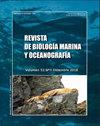Composición de la comunidad bioincrustante de un cultivo de ostras tropicales en un estuario del Amazonas, Estado de Pará, Norte de Brasil
IF 0.5
4区 生物学
Q4 MARINE & FRESHWATER BIOLOGY
引用次数: 4
Abstract
espanolResumen: La contaminacion biologica afecta a la acuicultura mundial con importantes impactos de productividad y rentabilidad, especialmente en el cultivo de moluscos, donde tanto la especie de cultivo objetivo como la infraestructura estan expuestas a una diversidad de organismos contaminantes. En el cultivo de ostras, el impacto clave es la adherencia directa de organismos causando dano fisico, interferencia mecanica, competencia biologica y modificacion ambiental, mientras que tambien se efectua la infraestructura. El presente estudio describe la composicion de la bioincrustacion en la superficie de la ostra de mangle Crassostrea rhizophorae, cultivada en un estuario Amazonico, ubicado en el estado de Para, norte de Brasil. En total, 6.124 macroinvertebrados fueron muestreados en julio, agosto, octubre y diciembre de 2013. La epifauna recolectada estuvo representada por 5 grupos principales (Bivalvia, Gastropoda, Polychaeta, Crustacea y Anthozoa), 20 familias y 37 especies. Bivalvia fue la clase mas abundante, presentando 5.183 mejillones de la especie Mytella charruana. El conocimiento sobre la composicion de la incrustacion biologica, asi como la identificacion de las principales especies que causan impactos directos, permite opciones de gestion mas personalizadas y estrategicas, minimizando los costos, a menudo significativos, asociados con el control de la bioincrustacion (antifouling). EnglishAbstract: Biofouling affects global aquaculture with significant impacts on productivity and profitability, especially in marine shellfish culture, where both the target culture species and/or infrastructure are exposed to a diverse array of fouling organisms. In oyster culture, fouling of stock causes physical damage, mechanical interference, biological competition and environmental modification, with infrastructure also colonized. The present study describes the composition of the biofouling community inhabiting the surface of the mangrove oyster Crassostrea rhizophorae, cultivated in an Amazon estuary, in the state of Para, northern Brazil. In total, 6,124 macroinvertebrates were collected during July, August, October and December 2013. Collected epifauna was represented by 5 groups (Bivalvia, Gastropoda, Polychaeta, Crustacea and Anthozoa), 20 families and 37 species. Bivalvia was the most abundant class, with the mussel Mytella charruana by far the most dominant species with 5,183 individuals. Knowledge about the composition of biofouling as well as identifying the main species that cause direct impacts allows more tailored and strategic management options, minimizing the often-significant costs associated with biofouling control (antifouling).巴西北部帕拉州亚马逊河口热带牡蛎养殖生物结垢群落的组成
西班牙摘要:生物污染影响全球水产养殖,对生产力和盈利能力产生重大影响,特别是在软体动物养殖方面,目标养殖物种和基础设施都暴露在各种污染生物中。在牡蛎养殖中,关键的影响是生物的直接粘附,导致物理损伤、机械干扰、生物竞争和环境变化,同时也影响到基础设施。本研究描述了生长在巴西北部帕拉州亚马逊河口的红树牡蛎Crassostrea rhizophorae表面生物结垢的组成。2013年7月、8月、10月和12月共采集了6124只大型无脊椎动物。收集的表观动物群由5个主要类群(双壳类、腹足类、多壳类、甲壳类动物和花生动物)、20个科和37个物种组成。双壳类是最丰富的类群,展示了5183种沙鲁阿贻贝。了解生物污垢的组成以及识别造成直接影响的主要物种,可以提供更个性化和战略性的管理选择,最大限度地降低与生物污垢控制(抗污染)相关的往往是重大的成本。生物污染影响全球水产养殖,对生产力和盈利能力产生重大影响,特别是在海洋贝类养殖中,目标文化物种和/或基础设施都暴露在各种各样的污染生物中。在牡蛎养殖中,股票的铸造会造成身体伤害、机械干扰、生物竞争和环境变化,基础设施也被殖民。本研究描述了居住在巴西北部帕拉州亚马逊河口养殖的红树林牡蛎Crassostrea rhizophorae表面的生物污染群落的组成。2013年7月、8月、10月和12月共收集了6124种大型无脊椎动物。收集的表观动物群由5个类群(双壳类、腹足类、多毛类、甲壳类动物和花生动物)、20个科和37个物种组成。双壳类是最丰富的类群,迄今为止,拥有5183个个体的Mytella Charruana麝香是最主要的物种。了解生物污染的组成,并确定造成直接影响的主要物种,可以做出更大的调整和战略管理选择,最大限度地减少与生物污染控制(抗污染)相关的往往高昂的成本。
本文章由计算机程序翻译,如有差异,请以英文原文为准。
求助全文
约1分钟内获得全文
求助全文
来源期刊
CiteScore
0.70
自引率
0.00%
发文量
41
审稿时长
12 months
期刊介绍:
Publicar desde una perspectiva científica, artículos originales, decididos por un proceso de revisión por pares, invitando a expertos de reconocido prestigio en el área. Los trabajos publicados se caracterizarán por su solidez teórica-metodológica, actualidad y relevancia para las ciencias marinas.
Se reciben trabajos inéditos derivados de la investigación científica realizada en ambientes marinos y estuarios, en formato de Revisión, Artículos, Notas Científicas, y Obituarios en las siguientes disciplinas::
Biología-Ecología marina
Oceanografía física, química y biológica
Contaminación marina
Geología marina
Sistemática, Faunística y Biogeografía Marina
Manejo Costero
Acuicultura marina
Pesquería marina.

 求助内容:
求助内容: 应助结果提醒方式:
应助结果提醒方式:


